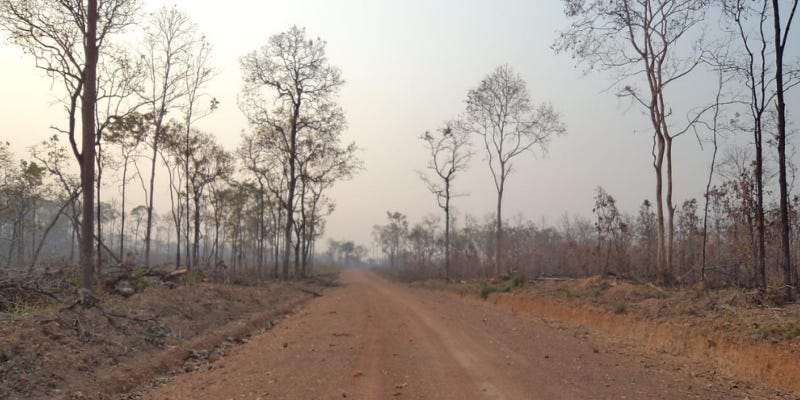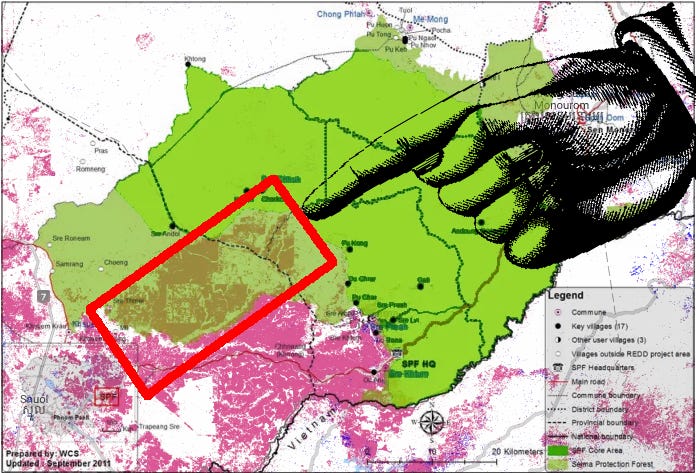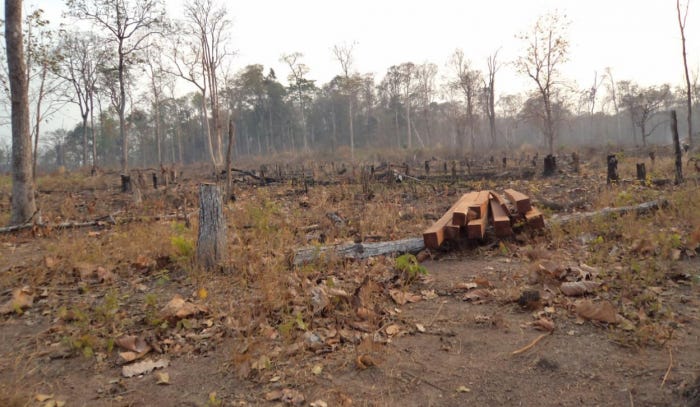Deforestation in Wildlife Conservation Society’s Seima REDD project in Cambodia
In July 2016, the Walt Disney Company agreed to hand over US$2.6 million for carbon credits from the Seima REDD project in Cambodia. REDD-Monitor wrote about the project in September 2016. The post included some questions for Tom Evans at Wildlife Conservation Society, the organisation running the project together with the Cambodia’s Forestry Administration. You can read Evans’ response here.
REDD-Monitor’s previous post noted that,
while there is little deforestation inside the REDD project, an area of the north-west part of the Seima Protection Forest has been deforested
This post takes a closer look at this area of deforestation and at what’s happening inside the REDD project area.
Discounted deforestation
This overlay shows the area of deforestation. It’s a WCS map of the REDD project area (from the Project Description) and Global Forest Watch’s deforestation map (the REDD project area is green, the Seima Protection Forest is a paler green, and tree cover loss is pink). To avoid any confusion, I’ve highlighted the area we’re talking about:
This area is an Economic Land Concession under the control of Vietnamese rubber plantation companies. A 2015 report published by Forest Trends states,
In the case of the Seima Protected Forest, approximately half of its high biomass evergreen forests (30,000 ha) were excised and allocated to ELCs in 2012, just as the REDD+ project activities were getting underway. The resulting forest clearance produced high emission levels in the 2012-2013 dry season with smoke plumes – and carbon emissions – streaming for more than 100 kilometers across Cambodia.
The map below, produced by WCS, clearly shows that the area cleared was lowland evergreen forest:
You may think that the deforestation of 30,000 hectares of lowland evergreen forest might affect the validity of the REDD project.
Er, no. Thanks to the wonders of REDD, the loss of 30,000 hectares of dense forest makes no difference whatsoever to the number of carbon credits generated by the project.
In a 2013 presentation, Dr. Alex Diment of the Wildlife Conservation Society explains that,
the project is of the “Avoiding unplanned deforestation and degradation” (AUD) type.
The project is only claiming credits generated from avoided unplanned deforestation.
Since 1994, the Seima Protection Forest has been under the mandate of the Forest Administration. In 2009, the Cambodian government passed Sub-decree 143 confirming this mandate, and making reducing carbon emissions an explicit objective.
In his presentation, Diment states that,
Planned deforestation from plantations or similar are illegal under the Sub-decree, and are not considered.
Of course, the fact that WCS doesn’t consider the deforestation on planet REDD, does not make the deforestation any less real on planet Earth.
Impacts of deforestation on Indigenous Peoples
In 2015, the NGO Forum on Cambodia and other NGOs put out a report about the impacts on Indigenous Peoples of clearing the forest for rubber plantations:
In December 2012, Benh Hoeurk Kratie Rubber 1 Company Limited used a large number of machinery to clear and to destroy indigenous communities’ land and resin trees in Chork Cha village.
Since then, systematic logging and felling of indigenous people’s resin trees have occurred actively both outside and inside the economic land concession (ELC) areas, which are part of the indigenous community’s land and the state public land.
The communities have protested against the company’s operations, lodging complaints with local and national authorities.
The Bunong Indigenous people living in Chork Cha village are registered as an Indigenous community. Their traditional use and ownership of the land, handed down from their ancestors, has been recognised by the village and commune local authorities.
The company has not produced an environmental impact assessment. It has not carried out public consultations. The Economic Land Concession has not been registered as state private land. The land conflict with the indigenous Bunong communities has not been resolved. The company has bulldozed the forest, cut resin trees, and destroyed forest outside the concession area. In the meantime the company has planted rubber trees on the disputed land.
Deforestation inside the REDD project
At the end of September 2016, Timothy Frewer of the University of Sydney visited the REDD project area. He saw indigenous Bunong children transporting timber on motorbikes from the REDD project area to a local sawmill.
Frewer visited two villages in the REDD area. He told REDD-Monitor,
“I was shocked to find that barely anyone in either village had any idea about REDD+. I asked about 15 people all up – including the commune chief who said REDD+ ‘was yet to be implemented’ and was only ‘meetings so far’. Even worse, I talked to the deputy communal land manager – who supposedly forms the pillar of the REDD+ project in the villages, who said they were yet to receive any budget at all for activities. In fact he had only come into contact with people from the project twice.”
At the same time, a timber company has been paying villagers to harvest timber within the project area and elsewhere. Villagers told Frewer they were “entirely powerless to stop” the logging company.
A WCS trip report dated January 2013, details deforestation in the northwest part of the REDD project area. A three kilometre-long, six metre-wide road had recently been constructed.
Forest along the road was cut and burned, and houses were being constructed. The report describes this as land grabbing by opportunists, who are clearing forest near the economic land concessions handed out to Vietnamese rubber plantation companies.









